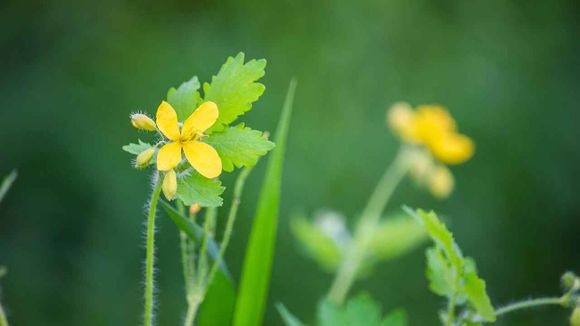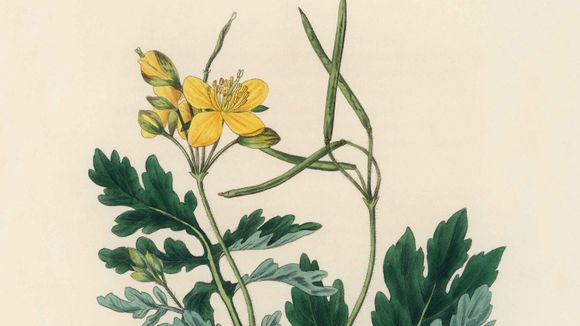What is Snake Milk (Chelidonium majus)
Contrary to expectations, snake milk has little to do with the cold-blooded animals that scare many people. Snake milk (Chelidonium majus) is a delicate, herbaceous two-year-old plant that reaches 30-80 centimeters in height. Its stems are ribbed and branched. When the branches or leaves are broken, you can see how to separate yellowish-orange juice, which slightly resembles snake venom. In larger quantities, this juice can be poisonous, and toxicity decreases significantly when drying the plant. This aspect will be analyzed later.
- Chelidonium Majus is native to Europe and is also found in the western and central part of Asia and North Africa. It is found from Portugal to the west, also in Central, Eastern and Northern Europe. The Asian range covers Turkey, Iran, Kazakhstan, Mongolia, the Caucasus and Siberia. In North America, it's an introverted plant.
- majus has been known as a healing species since ancient times. The healing properties of C. majus are described by Dioscoride and Pliny the Elder in the first century BC. The main medical use of jaundice, described from ancient times to the sixteenth century, is the treatment of visual impairments and eye diseases with the help of herbal juice. [ref. 1] Snake milk was used as a medicinal plant in the Middle Ages mostly for the treatment of eye diseases, throat cleansing, treatment of ulcers and skin eczema, as well as against colic and jaundice.
- Chelidonium majus is one of the most famous tools in folk medicine for the treatment of jaundice and liver diseases, such as inflammations, spastic conditions and gallstones. In Poland, the piece of young jaundice leaves was used as a bile agent and to regulate the action of the digestive tract. In some parts of Europe it is taken as an infusion of herbs to alleviate liver problems [ref. 2]
How does snake milk work?

An interesting assumption is that chemicals in Chelidonium majus can slow the growth of cancer cells, but can also be harmful to normal cells. Preliminary research has shown that a larger amount of snake milk can increase the flow of bile. There is also evidence of suspected painkiller properties of snake milk.
People use snake milk for digestive tract problems, liver and gallbladder disorders. Other possible areas of application include detoxification, relief of menstrual cramps, cough, chest pain (angina) and more. Despite the widespread use in folk medicine and in official phytotherapy, both in Europe and in traditional Chinese medicine, snake milk does not join the most popular herbal remedies such as chamomile, valerian, St. John's wort or ginseng. It is listed in pharmacopoeia and is available in pharmacies, but scientific evidence of the positive effects of Chelidonium majus is still limited.
For therapeutic purposes, dried herb of C. majus (European Pharmacopoeia) is used. In some regions (Central and Eastern Europe), the roots are also exploited.
The pharmacologically significant substances of C. majus are isoquinolin alkaloids. These are the components of latex produced in all parts of plants, except colors. Overall, five groups of alkaloids were found in C. majus. These are the derivatives of phenanthridine (3,4-benzoisoquinolin), protoberberin, protopine, quinolysidine, aporfin.
Several flavonoids were found in the above-ground parts of C. majus in low quantities. Four diglycosides and five monoglycosides have been identified as derivatives of kempferol, ivercetin and isoramnetin. Organic acids, ingredients of essential oil, biogenic amines such as histamine, saponins, vitamins A, C, nicotinic acid are part of the other active compounds in snake milk.
Pharmacological activities and clinical evidence
To date, the majority of the pharmacological properties of C. majus studied refer to the complex mixture or individual alkaloids contained in it. The various pharmacological actions of Coptisine, one of the main ingredients of C. majus, as well as smaller amounts of berberine, are widely described in the literature, but usually as compounds derived from other sources, such as Coptis (Ranunculaceae). [ref. 3]
From the growing evidence obtained both in vitro and in vivo, with several examples of ex vivo studies on isolated organs, it is clear that four types of medicinal properties predominate: antimicrobial and antiviral, liver and gastric, anti-inflammatory and finally anticancer:
- Antibacterial and antifungal - Antimicrobial activity of C. majus is attributed mostly to alkaloids and flavonoids, which have an inhibitory effect against S. aureus, S. epidermidis, P. aeruginosa, E. coli, Klebsiella pneumoniae, Salmonella gallinarum and other bacteria. Extracts of the plant have been tested for the antifungal effect against a large number of pathogenic fungi for humans and plants, that is. Aspergillus fumigatus, A. niger, Candida sp. Cladosporium herbarum and others. [Ref. 4]
- Antiviral action - Glucosamine glycan present in latex inhibits intracellular human immunodeficiency virus of HIV viral migration and blocks reverse transcriptase. In addition, individually tested five alkaloids of C. majus: helidonin, helleritrine, sanquinarine, coptizine and berberine, are able to inhibit the development of HIV-1. [Ref. 5]
- Antiparasitic properties - Extracts of herbs and water from roots, as well as sangvinarine (2–4 μg/ml), are highly effective in the treatment of trichomoniasis caused by Trichomonas vaginalis.
- Liver and bile ducts - One of the most common and repeatedly mentioned indications for C. majus, both in European/Mediterranean and East Asian traditional medicine, is for various liver complaints. Some of the hepatoprotective and biliary activities could be explained by the presence of esters of hydroxycanelene (caffeinic) acid. [Ref. 6] More and more in-depth research is needed on the action of snake milk to support liver and bile function.
- Antiproliferative, proapoptotic and cytotoxicity to cancer cell lines - Unlike hepatoprotective properties, this type of properties are quite well documented in a large number of studies. Most of all, it is assumed that some of the main alkaloids may cause cell death or stop the proliferation of cancer cells. This is based on the ability of berberine, helleritrine, sangvinarine and other alkaloids in the plant. [Ref. 7]
- Anti-inflammatory and immunomodulatory action - The ability to inhibit inflammation or, in some cases, to stimulate the immune response and mitigate excessive reactivity, can contribute to postulated anticancer properties and improve the symptoms of stomach disorders. Common extracts or isolated alkaloids have been tested, but scientists say there are other components, such as hydroxycanel derivatives, flavonoids and helidonic acid, presumably with a significant contribution.

Toxicity and safety problems
Given that one of the main spheres of application of the plant is for disorders of the liver and bile ducts, it should emphasize its toxicity in higher doses. Many messages from the 1990s have been documented in humans. The main symptoms include cholestasis and mild to severe liver damage with a fairly well-documented causal relationship in most cases. In total, more than 50 such cases have been reported from Europe, mainly from Germany.
However, no particular ingredient is directly related to the toxicity of the herb. On the contrary, it is assumed that drug interactions, not intrinsic toxicity, are responsible for the reported cases. In addition, individual hypersensitivity or allergy of a person to a compound should be considered.









